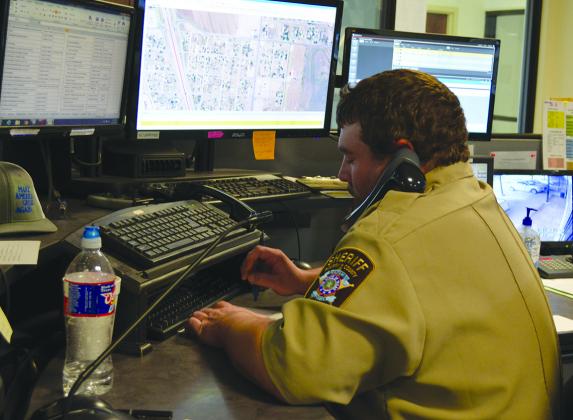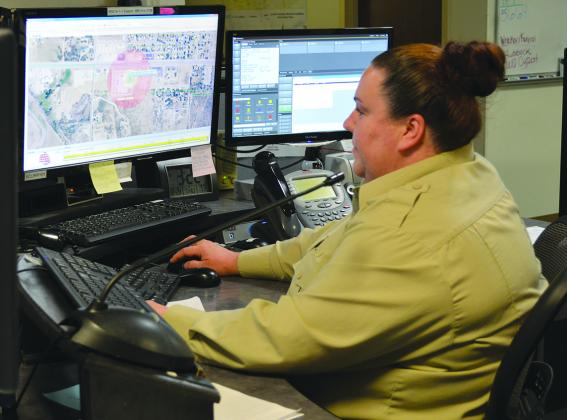First responders are quick to arrive at emergency scenes, but before they arrive, there is a crucial link that assists them.
Dispatchers are the true first, first responders, according to Scurry County Dispatch Supervisor and Deputy Jeanette Pritchard.
“Dispatchers are the life link between the person and the scene,” she said. “Our dispatchers dispatch for the city and the county. All 911 calls come through us. We dispatch for fire, police, EMS (emergency medical services) and DPS (Texas Department of Public Safety).”
While taking emergency calls may seem like a simple task, Pritchard said there is more to it than one might think.
“They are getting all of the radio traffic coming through while taking calls,” Pritchard said. “To be a dispatcher, you have to be good at multi-tasking. It takes skill, and not everyone can do it.”
According to Pritchard, dispatchers receive an estimated 3,700 calls per month.
At the Law Enforcement Center’s (LEC) dispatch center, there are three 911 lines for Scurry County, two 911 lines for Borden County and seven radio channels. Along with these, the LEC has three police department lines, two sheriff’s department lines and one jail line.
Scurry County also receives overflow 911 calls for Nolan and Mitchell counties when their lines are busy, dispatches wrecker services and receives home and business alarm alerts.
“The hardest part is working an accident when there’s four radios going off,” dispatcher Robbin Smith said. “Hearing all of the radio traffic at once can be difficult.”
While the multi-tasking can get overwhelming, Smith said the job is also rewarding.
“It feels good to be the first person they reach out to,” she said. “They come to us for different things.”
While dispatchers mostly receive emergency-related calls, not all of their calls are emergencies.
“My biggest thing is please don’t call 911 for non-emergencies,” Pritchard said. “That’s not because we don’t want to help but because we can’t tie up those lines in case there is a true emergency.”
With the advancement of technology, dispatchers are now able to communicate with almost anyone.
“They have access to Voyager, so if a person cannot speak English, they can quickly access a three-way call with an interpreter for any language,” Pritchard said. “Dispatchers are also trained in TDD, which is a telecommunications device for the deaf. Just because someone can’t speak English, doesn’t mean they shouldn’t call 911.”
Technology is good for communicating with callers, but Pritchard said it also has its downfalls.
“With technology, it’s made the job easier to some extent because you have so much more information available to you,” she said. “At the same time, they are responsible for so much more because of the advancement of technology.”
While the global positioning system (GPS) is helpful in locating callers, Pritchard said they can only find cell phone locations with about 98 percent accuracy. Because of this, it is crucial for residents to post their addresses so first responders can find their location more quickly.
“We need people to post their address numbers on their homes,” Pritchard said. “Sometimes when first responders get to a location, they are unable to locate the scene — especially out on county roads. We can get a pretty good idea of where the call is coming from through GPS, but it’s not always 100 percent accurate.”
Dispatchers are also responsible for checking the welfare of first responders at least every three to five minutes, depending on the severity of the situation.
In the past, working dispatch was considered a job, but in recent years, it has evolved into more of a profession.
“It’s good that it has become more of a profession because they have the most important job here,” Pritchard said. “Dispatchers are required to take and pass a state test to get their telecommunication license, and they must have 20 hours of training in two-year training cycles.”
Additionally, dispatchers may acquire different levels of telecommunicator certification. All levels of certification require an active license or appointment and training courses.
Basic telecommunicator certification requires one year of service. Intermediate telecommunication certification requires a basic certification, two years of service and 120 hours of training. Advanced telecommunicator certification requires intermediate certification, four years of service and 240 hours of training.
Masters telecommunicator certification requires advanced certification, eight years of service and 500 hours of training.
In Scurry County there are currently 10 dispatchers, two jailers and two deputies who hold telecommunicator certifications. Pritchard, jailer Katie Beall and dispatchers Daniella Garcia, Erminia Garza, Omega Vargas and Whitney Stewart hold master certifications. Dispatcher Jenna Quick holds an advanced certification. Dispatchers Azucina Gonzales and Melinda Owens and jailer Genia Montgomery hold intermediate certifications. Deputy Maggie Salinas holds a telecommunicator license. New dispatchers Smith, Tye Stone and Nicole Stowe hold temporary telecommunicator licenses.
Scurry County’s dispatch center is open 24 hours per day with at least two dispatchers on duty at all times.



